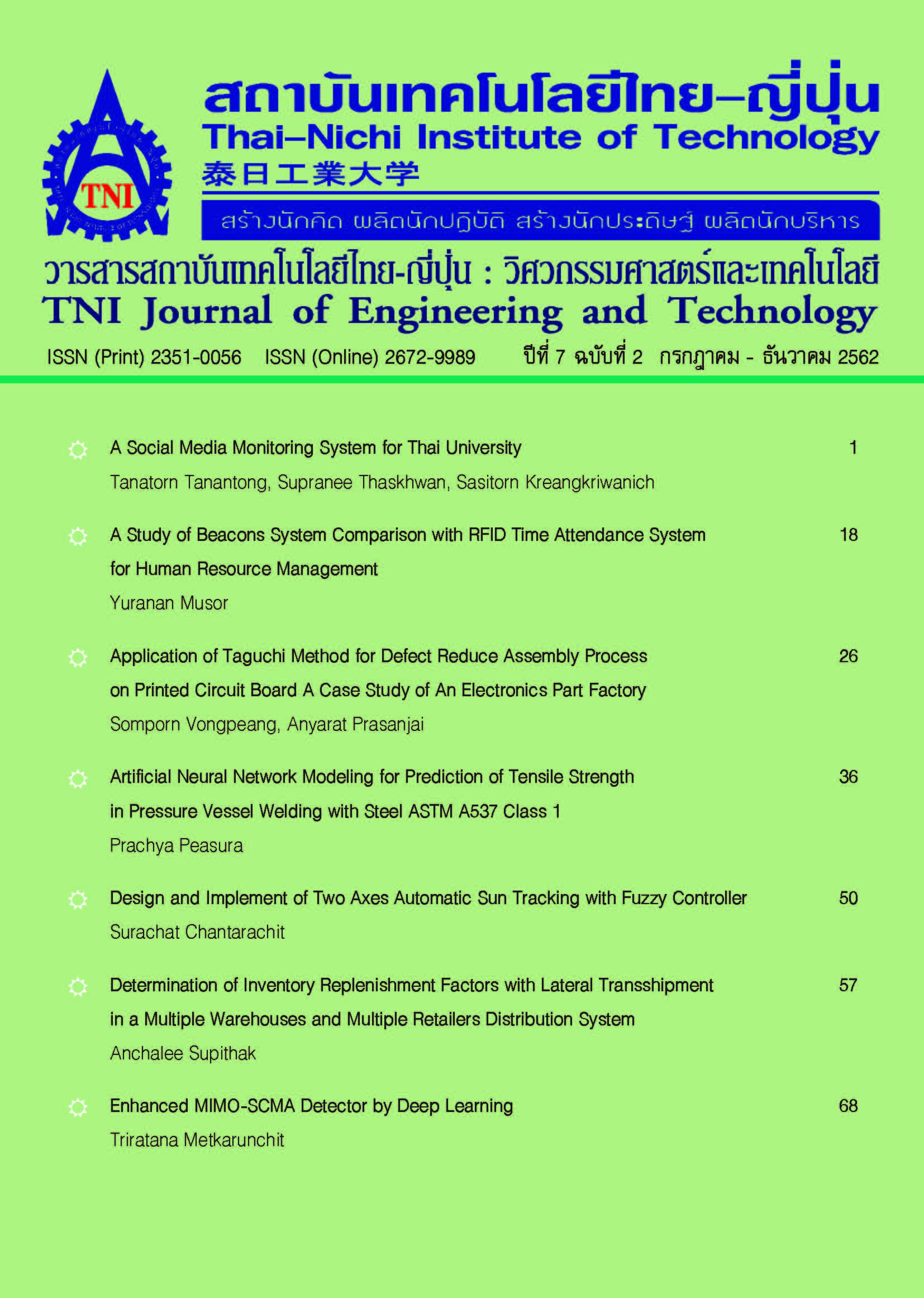Determination of Inventory Replenishment Factors with Lateral Transhipment in a Multiple Warehouses and Multiple Retailers Distribution System
Main Article Content
Abstract
The objectives of this research are to study the lateral transhipment of multiple warehouses and multiple retailers distribution system and to analyse the effects of related factors composing of demand dispersion and filling rate. The developed model is simulated by varying the demands at each location and the filling rate of demands at each location to observe the expected number of stockout in the system. The ten replications of each scenario are simulated and the results show that the total number of item’s stockout increases when demand dispersion is high. Retailer with the lowest demand in a distribution results in the highest number of units’ stockout. By varying the filling rate, the distribution with low dispersion demand among retailers trends to has lowest number of units stockout.
Article Details
Article Accepting Policy
The editorial board of Thai-Nichi Institute of Technology is pleased to receive articles from lecturers and experts in the fields of engineering and technology written in Thai or English. The academic work submitted for publication must not be published in any other publication before and must not be under consideration of other journal submissions. Therefore, those interested in participating in the dissemination of work and knowledge can submit their article to the editorial board for further submission to the screening committee to consider publishing in the journal. The articles that can be published include solely research articles. Interested persons can prepare their articles by reviewing recommendations for article authors.
Copyright infringement is solely the responsibility of the author(s) of the article. Articles that have been published must be screened and reviewed for quality from qualified experts approved by the editorial board.
The text that appears within each article published in this research journal is a personal opinion of each author, nothing related to Thai-Nichi Institute of Technology, and other faculty members in the institution in any way. Responsibilities and accuracy for the content of each article are owned by each author. If there is any mistake, each author will be responsible for his/her own article(s).
The editorial board reserves the right not to bring any content, views or comments of articles in the Journal of Thai-Nichi Institute of Technology to publish before receiving permission from the authorized author(s) in writing. The published work is the copyright of the Journal of Thai-Nichi Institute of Technology.
References
[2] R. H. Ballou and A. Burnetas, “Planning Multiple Location Inventories,” Journal of Business Logistic., Vol. 24, No. 2, pp. 65-89, 2003.
[3] T. Davis, “Effective Supply Chain Management,” Sloan Management Review Summer, 35-46, 1993.
[4] P. F. Wanke, “Consolidation Effects and Inventory Portfolios,” Transportation Research Part E: Logistics and Transportation Review, Elsevier, Vol. 45 No. 1, pp. 107-124, Jan. 2009.
[5] M. Ketzenberg, R. Metters, and V. Vargas, “Inventory Policy for Dense Retail Outlets,” Journal of Operation Management, Vol. 18, No. 3, pp. 303–316, 2000.
[6] S. C. Graves, “A Multiechelon Inventory Model with Fixed Replenishment Intervals,” Management Science, Vol. 42,No. 1, pp. 1-18, Jan. 1996.
[7] H. Zhao, V. Deshpande, and J. K. Ryan, “Inventory Sharing and Rationing in Decentralized Dealer Networks,” Management Science, Vol. 51, No. 4, pp. 531-547, Apr. 2005.
[8] R. J. Tersine, Principles of Inventory and Materials Management, 4th ed. New York: North Holland, 1982.
[9] R. H. Ballou, Business Logistics Management, 3rd ed.Englewood Cliffs: Prentice-Hall, 1992.
[10] J. Chen and J. Lu, “Influence of Lateral Transshipment Policy on Supply Chain Performance: A Stochastic Demand Case,” iBusiness, Vol. 2, pp. 77-86, Jan. 2010.
[11] D. Mangal and P. Chandra, “Inventory Control in Supply Chain Through Lateral Transshipment-A case study in IndianIndustry,” International Journal of Engineering (IJE), Vol. 3,No. 5, pp. 443-457, Nov 2009.
[12] J. Grahovac and A. K. Chakravarty, “Sharing and Lateral Transshipment of Inventory in a Supply with Expensive Low-Demand Items,” Management Science, Vol. 47, No. 4, pp. 579–594, April 2001.
[13] C. Paterson, G. Kiesmullery, R. Teunterz, and K. Glazebrookx, “Inventory Models with Lateral Transshipments: A Review,”European Journal of Operational Research, Vol. 210, No. 2,pp. 125-136, April, 2011.
[14] R. Patriarca, F. Costantino, and G. D. Gravio, “Inventory model for a multi-echelon system with unidirectional lateraltransshipment,” Expert Systems with Applications, Vol. 65,pp. 372-382, Dec 2016.

